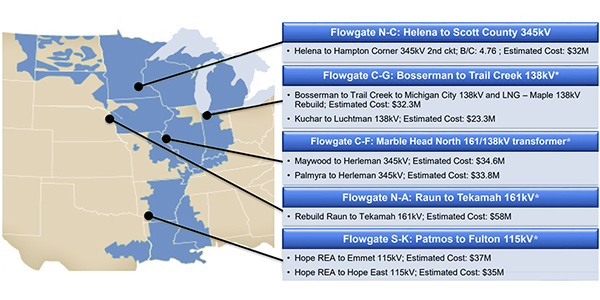By Amanda Durish Cook
MISO is evaluating nine projects to supplement or substitute for the contract path on SPP transmission linking its Midwest and South regions.
The RTO last week said it is still analyzing project ideas submitted by stakeholders, with nine projects passing the initial screening phase and multiple HVDC options undergoing further analysis, before completing the first round of screening.
It received 35 project ideas to reduce dependence on the North-South transmission constraint after it opened the floor to ideas in April, Economic Studies Engineer David Severson said during a conference call with stakeholders Thursday. (See MISO Seeking Proposals to Relieve North-South Constraint.)
The RTO now says its analysis will continue beyond the 2019 Transmission Expansion Plan (MTEP 19) deadline in December. In spring, staff said they weren’t bound to a deadline to submit any project recommendations and could take more time to conduct thorough testing of candidates.
“Given the uniqueness of some of the solutions we received … we fully expect the study to continue into 2020,” Severson said.
He added that MISO might try out new “exploratory” benefit metrics on the project candidates, although those metrics would not yet be applied to official benefit-cost ratio figures. The RTO has so far suggested it might incorporate the benefits of increased capacity flowing between regions as a new metric.
MISO currently relies on three metrics in its ratios, including adjusted production costs, the value of deferred or avoided reliability transmission projects, and the value of reducing power flows on the North-South constraint.
It will provide more updates on ideas later this year. Multiple stakeholders asked RTO staff to return with maps of potential transmission routes, a suggestion Severson said he would take under advisement.
8-Project Draft from Congestion Study
MISO will work through fall on its 2019 Market Congestion Planning Study, which now contains a shortlist of eight projects.
The RTO last month reported it was analyzing seven projects that passed the first round of screening. Those projects focused on just three congested areas, leaving MISO to compare multiple alternatives for just two congested areas. (See “Shortlist from MCPS,” MTEP 19 Revealing High Price Tag.) Additional projects are now in the running to solve interregional congestion.
The project shortlist has grown to eight after initial testing, with only one regional project focusing on a 345-kV flowgate in southern Minnesota, the $32 million Helena-Scott County 345-kV line, which stands to deliver a 4.76:1 benefit-cost ratio, MISO said. The project is now the best option out of three originally proposed to solve the Minnesota congestion.
While MISO has whittled down options on the lone regional project, the number of possible interregional solutions has grown.
The remaining projects address interregional flowgates, with three intended to ease two MISO-SPP flowgates in southwest Arkansas and on the Iowa-Nebraska border, and four addressing two MISO-PJM flowgates in northwest Indiana and western Illinois.
Possible MISO-PJM projects range in cost from $23.3 million to $34.6 million, while costs for the potential MISO-SPP solutions range from $35 million to $58 million.
All of the projects still must undergo further testing before they are deemed viable. Economic Studies Engineer Karthik Munukutla also said MISO is coordinating with SPP and PJM to figure out if they foresee benefits from the potential interregional projects.
“We want to make sure the projects we are testing stand the test of time,” Munukutla said.
He said staff will wrap up studies in August and reveal final recommendations at the Planning Advisory Committee meeting Sept. 25. “We will have all the recommendations there, both from an interregional and regional standpoint.”





